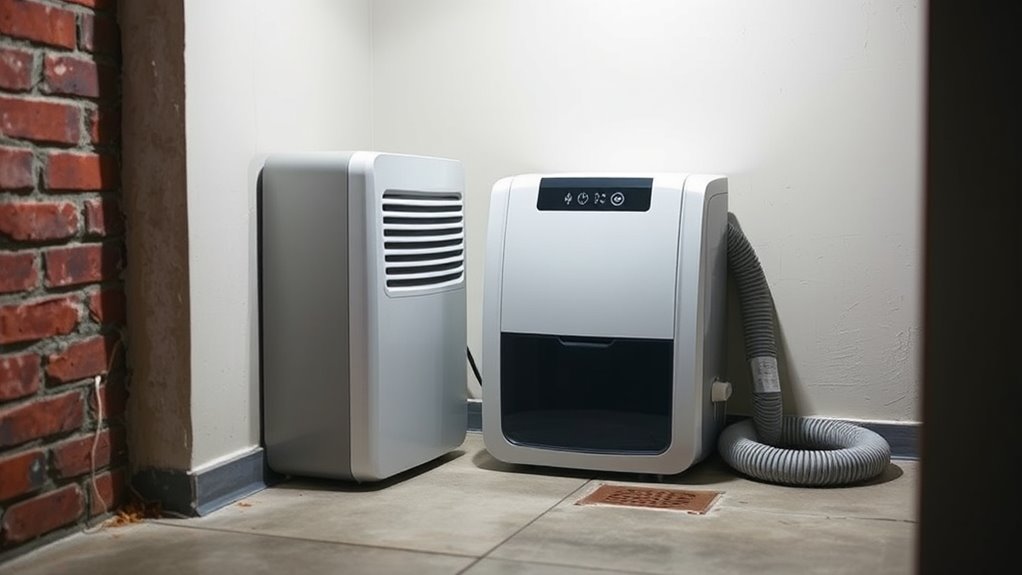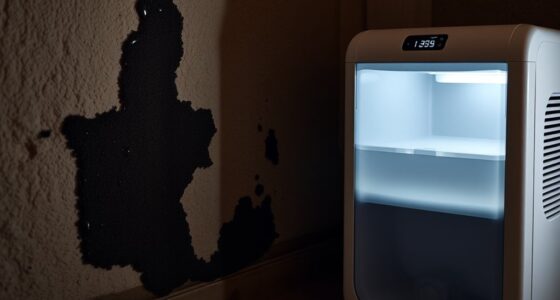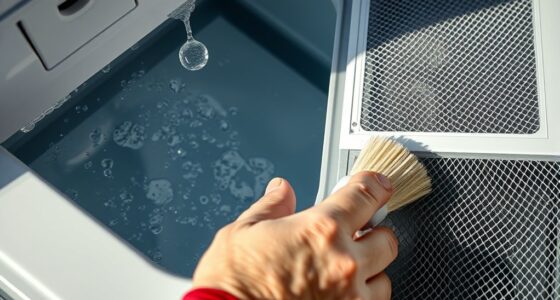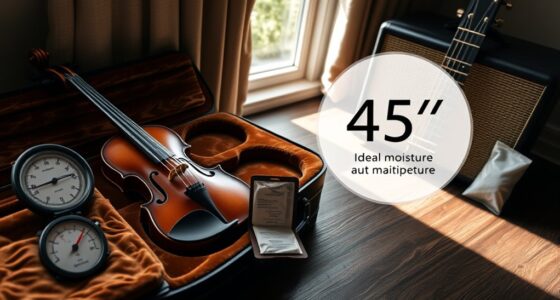To effectively control basement moisture, choose a dehumidifier with the right capacity for your space and place it centrally away from obstructions. Set the humidity level between 50-60%, using the built-in humidistat to maintain consistent moisture control. Run the unit continuously during humid months or after rain, and regularly check and clean filters to ensure efficiency. Proper drainage is key—use a pump or drain hose and keep everything clear. Keep exploring for more tips.
Key Takeaways
- Select a dehumidifier with capacity appropriate for your basement size for effective moisture removal.
- Set the humidity level between 50%-60% using the built-in humidistat to prevent mold and condensation.
- Place the dehumidifier centrally away from obstructions to ensure good airflow and optimal operation.
- Keep filters clean and replace them regularly to maintain airflow and efficiency.
- Use a built-in pump or drain hose for continuous water removal and prevent water accumulation.
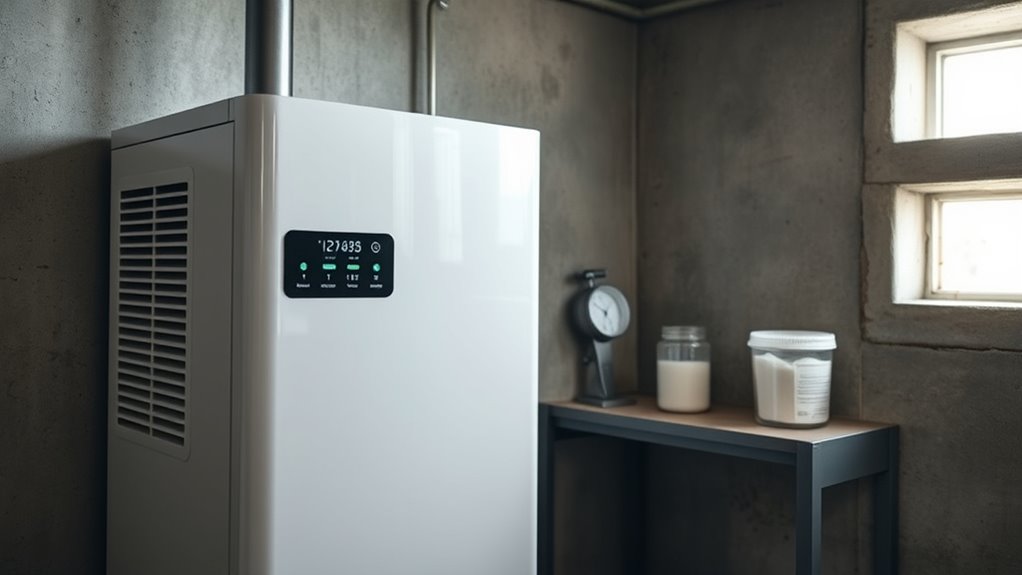
Moisture in your basement can cause serious problems, from mold growth to structural damage. To keep your space safe and comfortable, setting up your dehumidifier properly is essential. One of the key aspects of effective basement moisture control is choosing the right dehumidifier settings and understanding how to optimize its setup. Properly calibrated, your dehumidifier can significantly improve air quality and prevent condensation buildup, which are common issues in basements with excess moisture.
Start by selecting a dehumidifier with the appropriate capacity for your basement size. If your space is large, a unit with a higher pint per day (PPD) rating will work better, ensuring enough moisture removal to keep humidity levels in check. Once you’ve chosen the right size, place the dehumidifier in a central location, ideally away from walls or furniture that could obstruct airflow. Good airflow is crucial for efficient operation and optimal moisture extraction.
Next, set your dehumidifier to maintain a relative humidity level between 50% and 60%. This range strikes a balance—it’s low enough to prevent condensation, which occurs when warm, moist air contacts cooler surfaces, yet not so dry that it causes discomfort or static electricity. Many modern units have built-in humidistats that allow precise adjustments; use these to set and monitor the desired humidity level. Regularly check the display to ensure the unit is maintaining your target, and adjust as needed based on seasonal changes or weather conditions.
To enhance condensation prevention, consider running the dehumidifier continuously during humid months, especially after heavy rain or when the basement feels damp. This continuous operation helps stabilize indoor humidity and reduces the chances of mold growth. Additionally, keep the dehumidifier’s filters clean so it operates efficiently and maintains good air quality. Dirty filters can impair airflow, making the unit work harder and less effectively removing moisture.
Ensure proper drainage for your dehumidifier to avoid water accumulation and potential backflow issues. Many units have a built-in pump or a drain hose; use these features to keep the water away from your basement. If your dehumidifier doesn’t have a pump, empty the water reservoir regularly to prevent overflow. Regular maintenance, including monitoring dehumidifier settings, helps ensure optimal performance and long-term effectiveness.
Frequently Asked Questions
How Often Should I Empty or Clean My Basement Dehumidifier?
You should empty or clean your basement dehumidifier regularly to maintain effective dehumidifier maintenance and guarantee good basement air quality. Typically, check the water collection container every few days, especially in humid conditions. If your dehumidifier has a continuous drain option, ensure the hose is clear and functioning. Regular maintenance prevents mold and musty odors, keeping your basement environment healthy and comfortable.
Can I Use a Dehumidifier During Winter Months Effectively?
You can use a dehumidifier during winter months effectively, but focus on winter operation to guarantee it works well. Keep it in a space with some airflow and avoid blocking vents. Using it wisely helps improve energy efficiency, saving you money while controlling moisture. Just remember to set the humidity level appropriately, and your dehumidifier can help prevent mold and dampness all winter long.
What Size Dehumidifier Is Suitable for My Basement?
You want to choose the right dehumidifier capacity for your basement, and that depends on your basement size. Measure your space accurately; larger basements need a higher capacity unit, usually around 50 pints or more. For smaller areas, a 30-pint dehumidifier might suffice. Picking the right size ensures efficient moisture control, prevents mold, and keeps the air fresh. Always match your dehumidifier capacity to your basement size for ideal results.
Are There Specific Humidity Levels I Should Maintain Year-Round?
You should aim to keep your basement’s humidity targets between 30-50% year-round. During humid seasons, lower the setting to prevent mold and mildew, while in drier months, you might raise it slightly to maintain comfort. Seasonal adjustments help you control moisture effectively, protecting your space. Remember, consistent monitoring ensures you maintain ideal humidity levels, preventing excess moisture or dryness that could damage your basement.
How Do I Prevent Mold Growth With Dehumidifier Use?
To prevent mold growth, you should focus on maintaining proper humidity levels and optimizing your dehumidifier’s efficiency. Keep indoor humidity below 60%, ideally between 30-50%, to inhibit mold spores. Regularly empty the water tank and clean filters to guarantee your dehumidifier works effectively. Good air circulation and fixing leaks also help. These steps enhance mold prevention and ensure your dehumidifier runs efficiently, keeping your basement dry and mold-free.
Conclusion
By setting your dehumidifier just right, you turn your basement into a dry, welcoming haven instead of a damp, moldy cave. Think of it as guiding a gentle breeze through a hidden cavern, clearing away the moisture and revealing a clean, fresh space. With the right settings and setup, you hold the power to transform your basement into a sanctuary from moisture’s silent invasion. Take control, and let your home breathe easier today.
